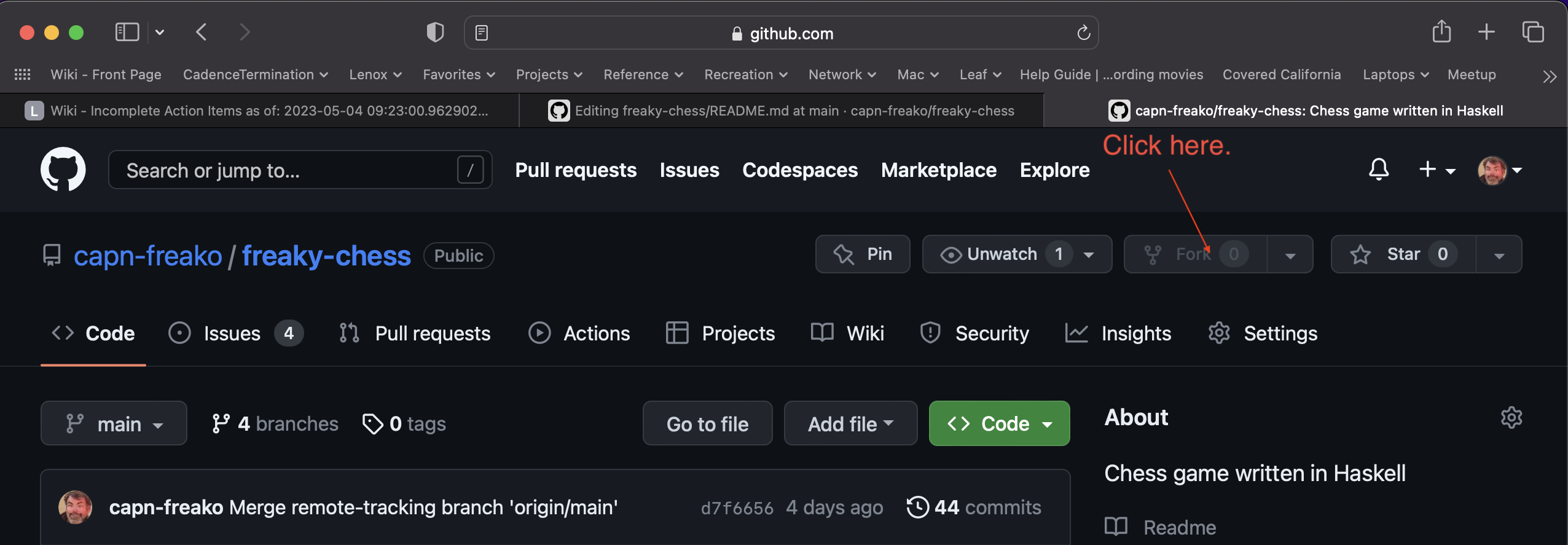This is a low bandwidth side hustle! You'll find that:
- the computer doesn't play very well, and
- the graphics are painfully '70s retro. :(
Note: If you intend to participate in the development of the code then:
-
Fork this repository:
-
Follow the remaining instructions, below, but in step 3 clone your new fork, instead of this repository.
-
When you're ready to contribute your first improvement and/or bug fix, contact me and I'll walk you through the process of submitting a GitHub Pull Request.
If you just want to install and play freaky-chess then follow these instructions:
-
Clone this Git repository:
-
At a command prompt, type:
git clone, paste what you just copied in step 3, and hit<RETURN>.Depending upon your platform and terminal application, pasting may be achieved using one of:
<CTRL>-v<CMD>-v<SHIFT>-<INSERT>
-
Move into the newly created directory and type:
stack build.You should see a lot of "work" being done by the
stackpackage manager and the Haskell compiler (GHC). This all may take some time to complete the first time it runs. -
Type:
stack exec freaky-chess-exe, and hit<RETURN>.You should be presented with a chess board and asked to make a move. Try:
e2 e4, to get the game rolling.
My aim here was not to invent a new competitor to Stockfish, but rather to go through the exercise of codifying reasonably good and shallow heuristics for board evaluation.
-
By reasonablly good I mean that I don't expect the computer to beat me, but just to maintain my interest and, perhaps, surprise me once in a while.
-
By shallow I mean that I intend to have the computer look no further ahead than, say, 5 moves, because that is about my own limitation.
What I'm really after is improving my own game play, by going through the exercise of codifying board evaluation heuristics.
I'm hoping that this execise in heuristic codification shifts my brain in a way, such that my own play improves.
I selected Haskell as my programming language for this project, for the following reasons:
-
Application development in Haskell is very fast and nimble. And I don't have a lot of time to give this project.
-
Haskell code tends to be easier for non-hackers to read and reason about than the other languages in which I'm proficient, for a couple reasons:
-
It is very succinct.
-
It reads more like math than other languages.
-
It has an analytical and functional nature, which most left-brainers find intuitive.
-
-
I've tried to take the breakout of subordinate (i.e. - "helper") functionality into separate, top-level functions to a pedantic extreme, specifically to facilitate meaningful discussion of the codified heuristics among hackers and non-hackers alike.
I seek to discuss the codified board evaluation heuristics with other Chess players (hackers or not) of a roughly similar level to myself, for the purposes of:
-
improving the code here, and
-
better understanding why certain changes work better than others, in the context of shallow evaluation (i.e. - typical Human play).
I don't speak Haskell and have no desire to learn. Can you quickly bootstrap my understanding of these "codified heuristics" and how you write them?
Taking the mobilityByPlayer() function as an example:
mobilityByPlayer :: PlayerScore
mobilityByPlayer clr brd =
sum $ map (length . validNewPos brd) $ positionsByPlayer clr brdIgnore the first line. It gives the functions type, which is not of immediate interest right now.
The function's definition starts with the second line, continuing onto the third (because of the indent there). It is most easily read from right to left, segmented by the "$"s as follows:
-
The
positionsByPlayer()function is called for the current player (clr), White or Black, given the current board (brd).- This function generates a list containing every board position occupied by a piece of the given color.
-
Some function,
(length . validNewPos brd), ismaped over that list, which just means that it gets applied to every element in the list independently, replacing that element with the function result.-
The actual function used here is a composition (indicated by the dot) of two separate functions:
length()andvalidNewPos(). AndvalidNewPos()comes "primed" with its first argument:brd. The net result at each element of the original list is:length(validNewPos(brd, <element>)) -
Decomposiing this result from inside to out:
-
The
validNewPos()function generates a list of all possible moves for the piece at a particular board position. -
The
length()just gives the length of this list, which is a measure of how many moves that piece could make, i.e., its mobility.
-
-
-
Finally, the
sum()function just adds up the mobilities of all pieces of the given color, yielding that player's total mobility.
Here is a screen shot of a game terminated after the second move:
Wrt/ score, positive numbers favor White, while negative numbers favor Black.


